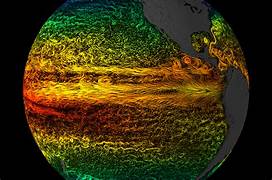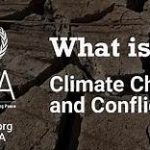Ocean Currents and Their Response to Climate Change
Ocean currents are a vital component of the Earth’s climate system, playing a significant role in regulating temperatures, weather patterns, and the distribution of nutrients across the globe. These currents, which consist of large-scale flows of water driven by wind, salinity, temperature differences, and the Earth’s rotation, help transport heat from the equator to the poles and influence ecosystems worldwide. However, with the ongoing rise in global temperatures due to climate change, ocean currents are being significantly altered, with profound implications for both marine and terrestrial systems.
This article explores the role of ocean currents in the global climate system, the impact of climate change on these currents, and the potential consequences for ecosystems, weather patterns, and human societies.
The Role of Ocean Currents in the Climate System
Ocean currents are driven by various forces, including wind, the Earth’s rotation (Coriolis effect), temperature gradients, salinity differences, and the shape of the ocean basins. These currents are classified into surface currents, deep currents, and the thermohaline circulation, each playing a critical role in global climate regulation.
1. Surface Currents
- Surface currents are primarily driven by winds and are most noticeable in the upper layers of the ocean. These currents help to transport heat from the equator toward the poles, significantly affecting regional climates.
- The Gulf Stream in the North Atlantic Ocean, for example, brings warm water from the Gulf of Mexico northward to the European coast, helping to moderate temperatures in Europe.
2. Thermohaline Circulation
- The thermohaline circulation, often referred to as the “global conveyor belt,” is a deep-water circulation that moves water throughout the world’s oceans based on differences in temperature and salinity. This circulation plays a pivotal role in distributing heat across the globe and influencing climate patterns.
- In particular, the sinking of cold, salty water in the polar regions drives this system, which in turn impacts the water temperature, nutrient cycles, and weather patterns on a global scale.
3. Upwelling and Downwelling
- Upwelling occurs when surface waters are pushed away from coastal regions by wind, allowing deeper, colder waters to rise to the surface. This brings vital nutrients to the surface, supporting marine ecosystems and fisheries.
- Downwelling, the opposite process, involves the sinking of warm surface waters, which helps to transport oxygen and carbon dioxide to deeper ocean layers.
Climate Change and Ocean Currents
Human activities, particularly the burning of fossil fuels, have led to an increase in greenhouse gases in the atmosphere, causing global temperatures to rise. This rise in temperature has started to influence ocean currents in a variety of ways, leading to significant changes in ocean dynamics. Below are some key mechanisms by which climate change affects ocean currents:
1. Global Warming and Surface Currents
- As the planet warms, surface water temperatures also rise. This changes the density and flow characteristics of ocean water, which can disrupt the natural flow of surface currents. For example, warmer waters are less dense than colder waters, which can lead to a slowdown of currents such as the Gulf Stream.
- In the Arctic and Antarctic regions, warming waters contribute to the melting of sea ice. This fresh water entering the oceans dilutes the salinity, making the water less dense and potentially weakening the thermohaline circulation. If this circulation weakens or collapses, it could drastically alter the climate, particularly in Europe and North America.
2. Melting Ice Caps and Freshwater Influx
- The melting of ice caps and glaciers due to rising global temperatures is contributing to a significant influx of freshwater into the oceans. This freshwater reduces the salinity of seawater, particularly in polar regions, where the density differences between warm and cold water are crucial to driving ocean circulation. The resulting disruption in salinity-driven currents can weaken the global conveyor belt, potentially causing a shift in regional climates.
- For instance, the melting of Arctic ice has been linked to a slowing down of the Atlantic Meridional Overturning Circulation (AMOC), a critical component of the thermohaline circulation. A collapse of the AMOC could lead to a drastic cooling of Europe, a rise in sea levels along the U.S. East Coast, and more extreme weather patterns globally.
3. Ocean Stratification
- Climate change has led to an increase in ocean stratification, which is the layering of ocean waters based on temperature and salinity. The warming of surface waters reduces the mixing of deeper, colder waters with surface waters, making the ocean less efficient at transferring heat and nutrients between layers.
- This stratification can have severe consequences for marine life, as it can disrupt the normal distribution of nutrients in the ocean. This, in turn, can affect the productivity of marine ecosystems, particularly in upwelling zones, which are vital for fisheries.
4. Changing Wind Patterns
- Winds are a primary driver of surface currents. As climate change alters atmospheric conditions, including the strength and direction of winds, surface currents are also affected. The intensification of the El Niño and La Niña phenomena, driven by changes in wind patterns, has already been linked to shifts in ocean currents, particularly in the Pacific Ocean.
- These shifts can have cascading effects on global weather patterns, influencing rainfall, droughts, and temperatures in regions across the globe.
Consequences of Altered Ocean Currents
Changes in ocean currents due to climate change are expected to have significant consequences, ranging from altered weather patterns to disrupted marine ecosystems. Some of the potential effects include:
1. Shifts in Regional Climate
- Altered ocean currents can lead to significant shifts in regional climates. For example, a weakening of the Gulf Stream could lead to colder temperatures in Europe, while coastal regions of North America may experience higher sea levels due to changes in the distribution of ocean waters.
- A slowdown of the thermohaline circulation could also cause more extreme weather events, such as stronger hurricanes and storms in the Atlantic, as well as altered rainfall patterns in regions like the Sahel in Africa.
2. Impact on Marine Ecosystems and Fisheries
- Ocean currents play a vital role in nutrient cycling, supporting the food chain in marine ecosystems. Disruptions in currents could lead to a decline in the productivity of marine environments, particularly in regions where upwelling occurs.
- Fisheries that depend on nutrient-rich waters may be severely impacted, threatening the livelihoods of millions of people who rely on seafood for food and income. The disruption of marine ecosystems could also lead to the loss of biodiversity, with species that depend on specific current patterns being at risk of extinction.
3. Rising Sea Levels
- Changes in ocean circulation, particularly the slowdown of the thermohaline circulation, could lead to rising sea levels in certain regions. Warmer waters expand, and the influx of freshwater from melting ice contributes to the overall rise in sea levels. Coastal communities, particularly in low-lying regions, are at risk of flooding and erosion.
- Rising sea levels can also increase the frequency and intensity of storm surges, which can exacerbate the impact of hurricanes and other extreme weather events.
4. Disrupted Weather Patterns
- Ocean currents are closely linked to atmospheric weather patterns. As ocean currents shift, they can disrupt the stability of these patterns, leading to changes in precipitation, temperature, and extreme weather events.
- The weakening of the Gulf Stream and other currents could alter the distribution of heat around the globe, leading to more frequent and severe droughts, floods, and heatwaves in different regions.
Conclusion
Ocean currents are a crucial component of the Earth’s climate system, playing a vital role in regulating temperatures, weather patterns, and the health of marine ecosystems. Climate change, driven by human activities, is causing significant disruptions to these currents, with profound implications for regional climates, global weather patterns, and marine life.
The potential consequences of altered ocean currents are vast and wide-ranging. From shifts in regional temperatures to the collapse of fisheries and rising sea levels, the effects of climate change on ocean circulation could threaten the stability of ecosystems and human societies.
To mitigate these impacts, urgent action is needed to reduce greenhouse gas emissions and limit global warming. In addition, continued research into the dynamics of ocean currents and their response to climate change is essential for developing effective adaptation strategies and ensuring the long-term health of our oceans and climate system.


